Execution#
Executing apps#
The "Apps" window allows you to manage the applications that you want to run, and the different configurations that can be used with them.
It also allows you to manage Quick links, which are simply a combination of an app and a configuration.
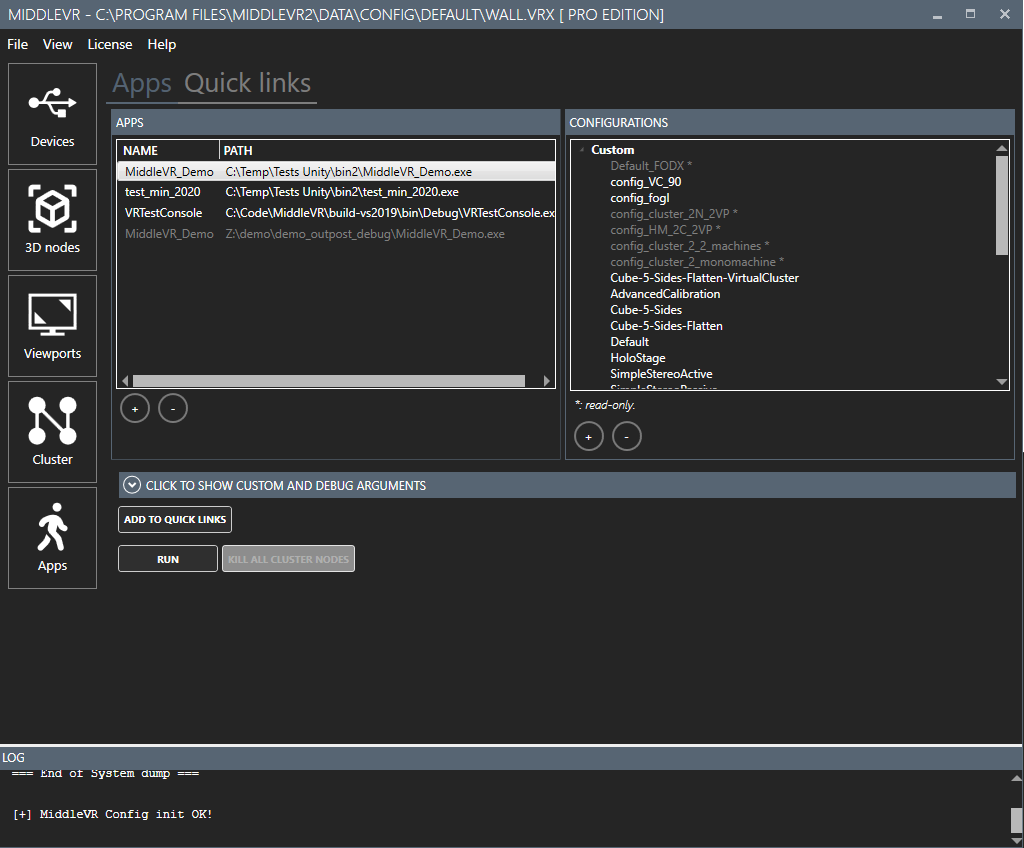
You need to select both an App and a Configuration before pressing "Run".
Pressing "Run" will execute the App and instruct it to load the selected configuration.
Cluster#
Make sure you have the MiddleVR Daemon running on all machines, including the server.
If the configuration is a cluster configuration, it will send the command to all the cluster daemons, including the master.
Note: If you are using a network drive, make sure to add the application and configuration from this network drive. MiddleVR will tell all nodes to use the exact same command line, so if you're adding your application from a local folder that does not exist on the cluster nodes, the VRDaemon will not be able to start it.
Stopping a cluster application#
The easiest way to stop an application is by pressing the Escape key on the server's keyboard.
If the application is frozen, you can also use the "Kill All Cluster Nodes" option in the apps window:

Pressing this button will send a message to all MiddleVR Daemons to kill the last applications that they started.
Apps#

You can sort the apps list as you wish by dragging and dropping the app where you want in the list.
Double-clicking on an application in the apps list will open a file explorer in the folder containing it.
By right clicking on an app a menu lets you choose between removing the item from the list or show it in the explorer.
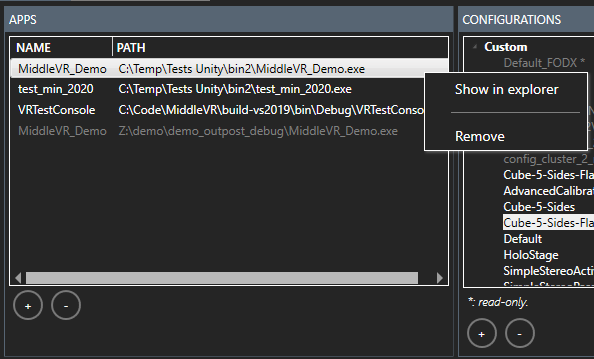
Double-clicking on a configuration in the configurations list will load it.
Renaming a configuration will also rename the file. Duplicating a configuration will duplicate its file on the disk.
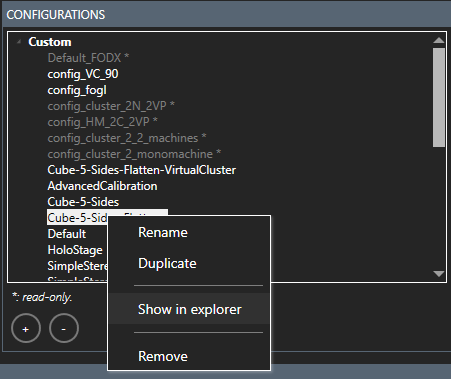
- A gray configuration is a configuration whose file does no exist on the computer.
- A bold configuration is a loaded configuration.
Note: You can also edit the name of the selected configuration or the selected category the by pressing "F2".
By pressing the "Add to quick links" button a new quick link will be created in the "Quick Links" view.
Custom arguments and Debug information#
You can expand the Click to show custom and debug arguments section:
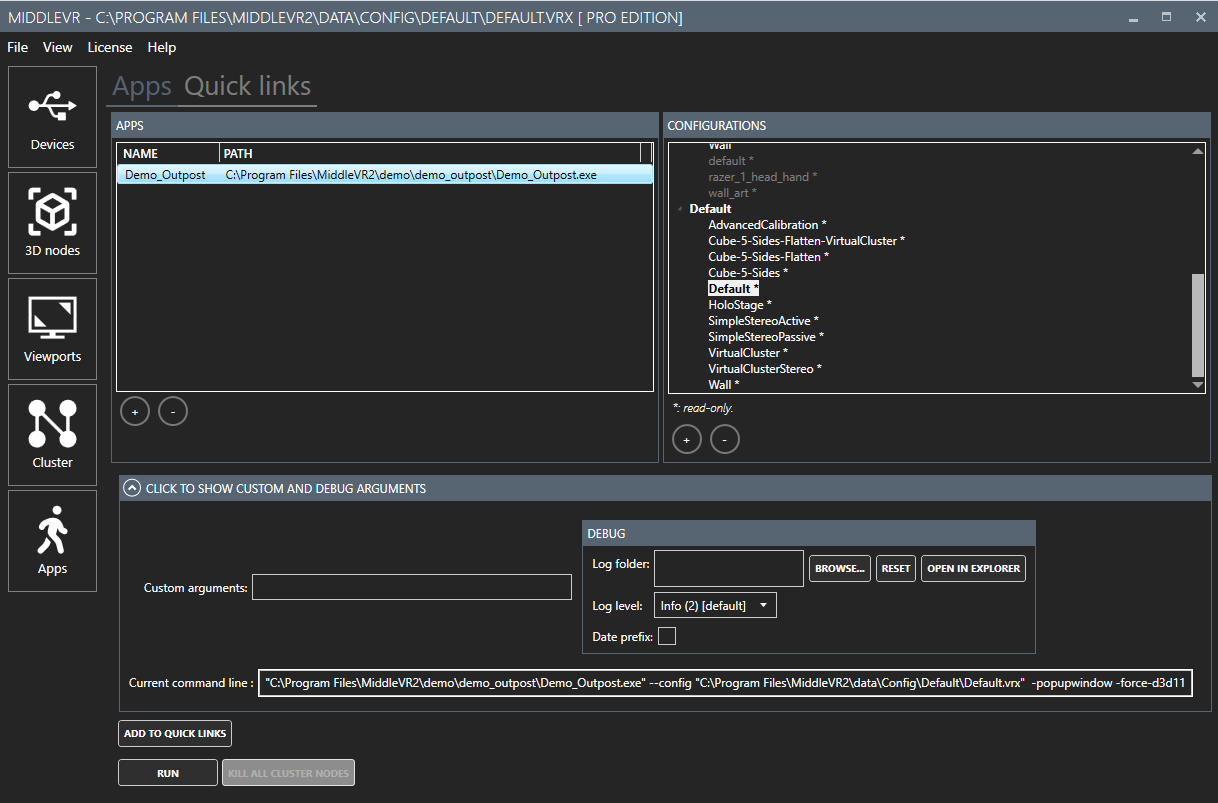
You can see the full command line that will be sent to cluster daemons in "Current Command Line".
You can add a custom argument to the command line in "Custom arguments".
-
Log folder : The folder where the logs will be stored. MiddleVR will automatically create a new folder for each day inside this folder. This parameter is especially useful to output logs to a shared network folder so it is easier to gather the logs from all the clients. Depending on the loglevel, writing logs on a network file can slow down the application down. If empty, the logs will be created in
%tmp%/MiddleVR -
Log level : The level of logs that will be printed in log files when the application runs.
-
Date prefix : By default all the logs will be created prefixed with the launch date and time. You can uncheck this parameter so the log names don't change every time you run your application, which can be useful to debug.
The log level can be from 0 to 7:
- LogLevel 0: will only display errors,
- LogLevel 1: will only display errors and warnings,
- LogLevel 2: will only display errors, warnings and information,
- LogLevel 3 or more: debug information.
Manual Execution#
You can also manually start the application without the graphical tool. On the server, you can execute the application by creating a .bat file and copy/paste the command line given by MiddleVR Config in Debug information.
MiddleVR will then tell the MiddleVR Daemons of all the configured cluster clients to run the same application with the exact same path and command line arguments.
This is particularly useful with Editor Cluster Debugging.
Quick Links#
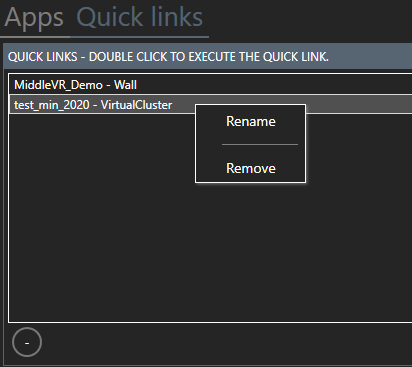
The main list manages the quick links. A quick link is the composition of an app and a configuration plus custom arguments. By clicking the "+" or "-" you can add or remove quick links from the list. By clicking the "+" button the "Add Quick Link" window will appear.
You can sort the list as you wish by dragging and dropping the quick link where you want in the list.
By right clicking on a quick link a menu lets you choose between removing the item from the list or renaming it.
Note: You can also edit the name of the selected quick link by pressing "F2".
Double clicking on a quick link will load its configuration and execute the linked application using the custom arguments it contains.